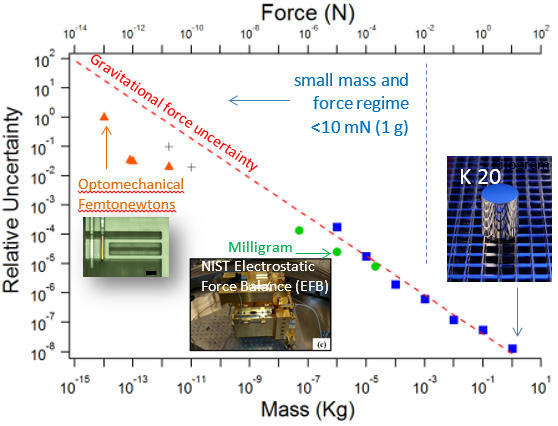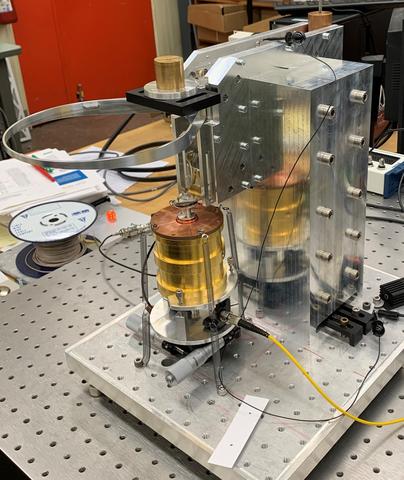Summary
The small mass and force metrology project at NIST leverages the redefinition of the International System of Units (SI) to scale mass and force with electrical metrology via electrostatic force measurements, and with laser power using photon momentum force measurements. The uncertainty and convenience in measurement of force from femtonewtons to millinewtons and in mass from micrograms to milligrams has been reduced substantially using these alternative methods.
Description
Project 1: The electronic milligram. As a result of kilogram redefinition within the SI, it may be possible to realize mass at the milligram level and below using electrical measurements. To this end, the NIST Electrostatic Force Balance (EFB) has been used to measure the mass of artifacts spanning the range from 50 micrograms to 20 milligrams. The measurement precision of the EFB methods result in 1 to 2 orders of magnitude less uncertainty in mass than subdividing the kilogram within this range. The EFB can also be used to calibrate other small force sensors, such as those used in Atomic Force Microscopy (AFM), and several different international comparisons have been undertaken to validate the EFB for this purpose.

Project 2: NIST-on-a-chip optomechanical methods for calibration of mass, force, laser power and other quantities. We have developed miniaturized self-calibrating sensors capable of interconverting mass, force and laser power using frequency measurements based on photon pressure forces. The goal of this project is to create an embedded reference for these types of measurements to simplify the calibration process for industry, and to examine whether a laser power or attonewton force standard can be developed from a discrete number of countable photons. At a slightly larger scale, we are constructing a photonic force balance, similar to the one used in the electronic milligram experiment described above, to directly realize optical power using electrical metrology in collaboration with the Electronic Kilogram and the High-Power Laser Applications projects. The picture below shows the prototype balance that is designed to serve as a primary reference for optical power above 1 kilowatt in conjunction with the High Amplification Laser-pressure Optic (HALO).

Project 3: True Becquerel. Recent advances in superconducting Transition Edge Sensors (TESs) allow ultrasensitive thermal measurements. As a result, it is possible to measure the energy and number of radioactive decay processes, providing enough information to fully characterize the activity of a radioactive sample. This provides a new pathway to realize the SI unit of radioactivity, the becquerel. Standards and reference materials are often provided by NIST as liquid solutions of radioactive materials, and their activity specified in becquerels per gram of solution. A precision measurement of the milligram mass of liquid standard deposited on the TES is required to complete the measurement. For this purpose, a NIST Innovation in Measurement Science (IMS) project began in 2021 to create a measurement chain harnessing the electronic milligram and NIST-on-a-chip advances to provide a new realization of the becquerel.

